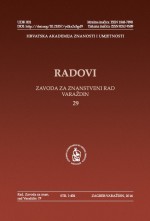GLINENE LULE IZ FUNDUSA ARHEOLOŠKOG ODJELA GRADSKOG MUZEJA VARAŽDIN
CLAY TOBACCO PIPES FROM THE ARCHAEOLOGICAL DEPARTMENT COLLECTION OF THE VARAŽDIN CITY MUSEUM
Author(s): Jere DrpićSubject(s): Archaeology, Museology & Heritage Studies, Local History / Microhistory
Published by: Hrvatska akademija znanosti i umjetnosti - Zavod za znanstveni rad Varaždin
Keywords: tobacco; clay pipes; Varaždin; Varaždin county;
Summary/Abstract: Clay tobacco pipes from the collection of the Archaeological Department of the Varaždin City Museum were found during archaeological research, with one exception, in the wider area of Varaždin County. So, there is a pipe from the city of Lepoglava and two from the cave Vindija. Nevertheless, most of them were found in the area of the historic nucleus of the city Varaždin (27), in the wet ditch of the varaždin fortress colled Stari grad. Also, more of them are a result of the archaeological surveillance in the city itself; In the streets of Branko Vodnik and Petar Preradović, and from the surroundings of the church of St. Florian. All of these pipes belong to the eastern or Mediterranean group, with one exception that we attribute to the west, that is found in the ditch of the Old Town (cat. 1). The east is represented by two main types; Austro-Hungarian and Turkish. Most of the findings belong to the Austro-Hungarian type (cat. 7-30), and within them there is a larger group of Schemnitza pipe from Ban Štiavnica or their imitations (Grades 7-16), with the stamps of the workshops M. Hönig Schemnitz, Bodnar Schemnitz, Leop. Gross Schemnitz, Selmecz. They are to be traced to the 19th century of the pipe group (cat. 18-23) and can be attributed to Austrian workshops, and to the workshop of Josepha Partscha in Theresienfeld due to the stamp of the pipe (cat. 18). The examples (cat. 17) with the stamp LSLESINGER are attributed to the Hungarian workshop in the town of Papa, and the postal code PODRECS (cat. 24) are attributed to the production at the slovak workshop in Podrečany. There is also a group of so called café tobacco pipe (cat. 25-30), which we attribute to the production in Meidling, Vienna (cat. 25), then in the german city Cologne (cat. 26) and slovak Kolin (cat. 27-30). This production in Kolin can be recognized by the typical net decorations, which all date to the half of the 19th century. Turkish type is represented by 5 samples (cat. 2-6). It is a group of pipes that can be attributed to the so-called Borderland-type pipes. They belong to the group of the oldest found pipes of Croatia in the second half of the 17th century, and were used in borderland areas colled Vojna krajina or Militärgrenze, the area under militar rule of Habsburg monarchy, bordering the Ottoman Empire. Chronologically, this whole group of pipes from the Varaždin City Museum with 30 samples covers the period from the very beginnings of smoking in the 17th century, until the end of mass production and production at the end of the 19th century.
Journal: Radovi Zavoda za znanstveni rad Varaždin
- Issue Year: 2018
- Issue No: 29
- Page Range: 9-41
- Page Count: 33
- Language: Croatian

